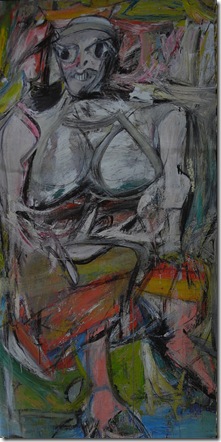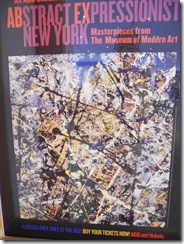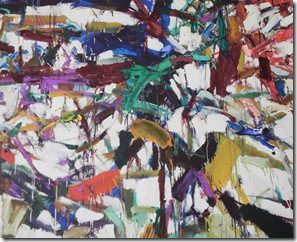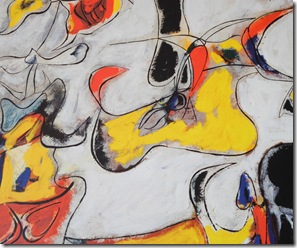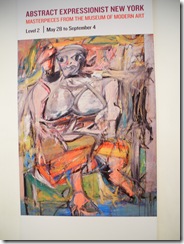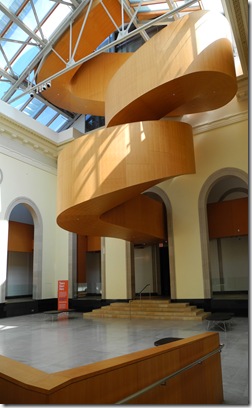
These abstract generalities apply to almost every school of art that has ever existed, including the cave drawings in southern France. Jackson Polack is quoted as saying, “Every artist paints what he sees.” This shallow statement appears beside his painting “Number 1A” painted in 1948. If the canvas portrays what the artist saw in his creative imagination, then he needed to get more and observe the world around him. A photo accompanying the canvas depicts Pollack crouched above the massive canvas applying large brush strokes and dabs of colour from a distance of several feet.
The accompanying text explains that because he did not use an easel and was in motion above the canvas, he could paint freely, employing his whole body. It states that this was a break with tradition and a new approach to painting. Pity that Pollock never saw kindergarten children in a classroom, with their large sheets of newsprint spread out on the floor, hovering over them as they employ broad free-moving brush strokes. Their works look the same as Pollack’s. In many instances, the kindergarten creations are much more interesting as they are less inhibited and employ colours with an exuberance and purity that mature artists can rarely capture. The problem with kindergarten artists is that they never know when to stop.
Mark Rothko’s painting “No. 5/No.22” (left) is a canvas that resembles a flag that is vertical. The accompanying explanation states that if you stare at the colours, they hover above the surface. This is indeed the “power of suggestion.” There is neither sufficient contrast among the colours nor sufficiently strong lines to create this effect, but hell, if you tell people this happens, many will see the effect and feel superior to those that were unable to experience it. As for the idea, and I quote, “if stared at individually they (the colours) affect the colour of those adjacent to it.” Well of course they do. If you stare at a colour intensely for ten or twenty seconds, and then shift your gaze to another colour, the eyes continues to see the previous colour for several seconds.
This was a trick that I was exposed to in the schoolyard in my primary school days. Kids brought cards to school with black designs on them and told us to stare at them. When we looked away, the “magic” symbol appeared in the air for several seconds after you looked away. Staring at something colourful and then switching your gaze always affects the new image.
A canvas entitled “Abstract Painting,” created between 1960 and 1961 by Ad Reinhardt, is a large canvas painted solely in black. The text informs us that at first glance it is solid black, but on closer examination one is able to see that it is actually hundreds of shades of black. Well of course it is. First of all, canvas reflects the ambient light unevenly, creating many different shades of black. Any solid colour is excellent for this effect. In addition, a canvas surface absorbs paint unequally, and the amount absorbed affects the intensity of the colour, thus producing varying tones. As for the geometric shapes that the notes declare are beneath the colours, these too can be caused by the canvas. A canvas has vertical and horizontal lines in the woven fabric, and flaws that create diagonal lines.
Examine Willem De Kooning’s “Woman 1” painted in 1951-2 (left). The brush stokes are crude, the lines clumsy, and the overall effect is ugly. I can’t even admire the work for its originality, as it is a Picasso on a bad-hair day. The artist said he “wrestled with it for months . . . numerous preliminary studies, and at time abandoning it.” All right, but how much time was actually devoted to the painting? Certainly not two years, as the notes imply.
According to the notes the AGO provides at the entrance to the exhibition hall, the world at large took notice of the abstract expressionist artists because in 1950 a letter was sent to the New York Times about the conservatism of the art scene in New York. Since the letter arrived on a day with very little to report, the newspaper published it the following day on its front page. Life magazine read the letter and investigated. The resulting publicity caused the public to take notice of the artists.
I do not wish to imply that there is something wrong with liking the abstract expressionist painters. Art is highly personal. Various types of literature, food, wines, music etc. all have their detractors and promoters. This is as it should be. However, I object to passing their works off as great art. Doodles, splatters, drips, hand prints, etc. can be interesting and entertaining to the eye. Their colours may match the interior of a room, and provide pleasing designs to augment a certain decor. However, as the skill level is very low, I do not feel that they qualify as great art.
There is another aspect to consider. Because of the work of the abstract expressionists, we have lost the creative talent of two generations of artists who have imitated their style. I have seen young artists who possess immense talent, waste their time dribbling, flicking, splattering, and dabbing paint on huge canvases. The truly great work they might have created was never even attempted.
I know it’s fun for artists to engage in the abstract expressionist style, as it allows them to escape from the tedium of employing skills that are difficult to master. Then, when the work is not accepted or is criticized, the artists retreat behind the excuse, “you do understand the work.” Lovers of abstract expressionism often employ this line of reasoning. If you do not appreciate the school of work, they tell you that you do not understand it. The problem is, there is nothing to understand. It’s spontaneous doodles and splashes of paint. Pretty perhaps, eye-catching certainly, but great art?
Jackson Pollock stated: “The modern painter cannot express this age, the airplane, the atomic bomb, the radio, in the old forms of Renaissance or any other past culture. Each age found its own techniques.” Pollock was right, but does his art really express any of the ideas he mentions? Anyone who thinks that his art captures the age of the 1940s, had best do a little research on the era. However, I may be wrong, so go see the exhibit and judge for yourself.
Arshik Gorky wrote” “Abstraction allows man to see with his mind what he cannot see physically with his eyes.” This is a meaningless verbal escape hatch. It implies that if you cannot see what abstraction is portraying, then you do not have the mental capacity to perceive it. Slightly condescending?
The exhibit at the AGO states that “Abstract landscapes evoke the beauty and complexity of the abstract world.” Another meaningless statement. It’s inward looking and makes as much sense backwards as forward. “The abstract world evokes the beauty of the abstract landscapes.” A meaningless use of language. When you visit the exhibit at the AGO, ask yourself, how much beauty do you actually see.
The pictures below were taken from the posters outside the AGO and the brochure the gallery provided. I urge people to go see the exhibit. But keep an open mind. Ask yourself how much skill was required to create these canvases. Do not accept being told what to think by the accompanying documentation. Is a failure to appreciate these works really a lack of intellect? It might be simply be the ability to see that “the emperor has no clothes.”
Most of the texts and explanations accompanying the canvases are advertisements trying to sell a product, in this instance, a painting. It’s marketing. If you buy the product being offered, great!
However, you may think the exhibit is much to do about nothing.
Poster advertising the exhibit Painting by Joan Mitchell – “Ladybug”
“Garden in Sochi” by Joan Mitchell “Woman1” by William De Koonig
An article in the Globe stated that when a cross-section of people were asked to compare the work of these artists with the efforts of a young child and that of an ape, 60 percent preferred the abstract impressionist artists. The reporter stated that this proved the superiority of the abstract impressionist masters.
This conclusion deserves closer consideration. Remember, 40 percent of the viewers preferred either the work of the child or the ape, or admitted that they were unable to tell the difference. This is a damning statement to reveal about any school of art. If this is the art that made New York the centre of the world of modern art, New York is in trouble.
If the people who compared the art of a gorilla and a young child with that of the abstract expressionists had examined the abstract paintings below, I wonder which they would have preferred?
By now you have likely guessed that the above is graffiti art. It is from the walls of Graffiti Alley, near Queen St. and Spadina Avenue. Compare the skills required to produce this art with that of the abstract expressionists. You may also wish to consider which art is more interesting.
I think it is great that the AGO brought the abstract impressionist canvases to Toronto. After all, if they had turned it down, other galleries would have jumped at the chance to have the exhibition. Besides, art is personal, and beauty is in the eyes of the beholder. However, I can’t help but feel that no one wants “to bell the cat” and admit that the canvases are not great, and in many cases, not even interesting.
However, I urge you to go to the AGO, see the exhibit and make up your own mind. Then, visit the other galleries to compare the exhibition with other schools of art. Ask yourself, how much skill was required to create the painting? You might also want to include Graffiti Alley in your explorations.

